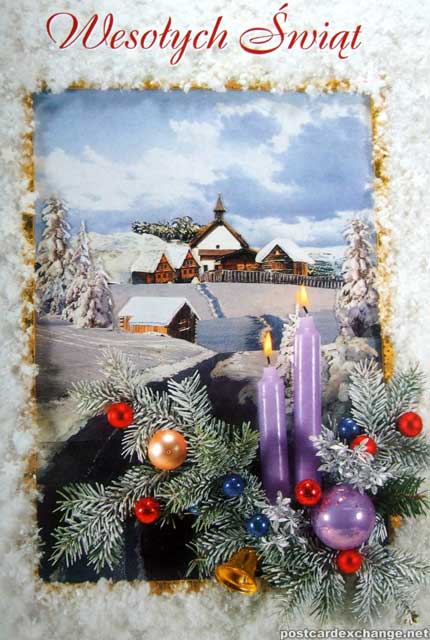Christmas in Poland
‘…some old traditions can still be found among village people who tend to lead a more old-fashioned lifestyle, closely connected to nature and its cycles of death and rebirth.’
A blend of religious fervor--and ancient superstitions--are the main ingredients for a warm and festive holiday season in Poland.
The szopka or nativity creche is often an integral part of Christmas observances in churches, as well as in homes, where plans are busily made throughout December for another important centerpiece of a Polish Christmas--the holiday feast.
Christmas Eve is when Poles gather for the main celebration, filled with wonderful traditions beginning with bits of straw laid down under the holiday table cloth as a reminder of Jesus' humble birth in a stable.
Next, comes the observance of Gwiazdka, or "little star" as the sky is carefully watched for the appearance of the first star of the night--in remembrance of the Star of Bethlehem. The moment the star appears, families may begin the ceremony of feasting, or wigilia, deriving its name from the old Latin, "to keep vigil.”
Dinner begins with a special rice wafer called oplatek, which is broken into pieces and shared by all. Next, the old custom of seating an even-number of people around the holiday table (lest bad luck befall someone) is still followed by some families, who also may arrange for a seat to be left empty for a wanderer in need, or in remembrance of a deceased relative.
The customary 12 dishes are usually served as a symbol of the 12 apostles, and include generous helpings of the traditional carp, borscht, soup wild mushroom, perogies, pickled herring, and noodles with poppy seeds.
Any number of desserts may also be on the menu, including a traditional cwibak (Christmas fruit cake), piernik (honey cake), and baba rum.
Christmas in Poland
***
OF SINKING TREES AND ROLLING EGGS: CHRISTMAS EVE SUPERSTITIONS
Customs to ensure a betrothal or good harvest were a major part of rural Polish Christmas time traditions.
For Poles, Christmas Eve is a time of family gathering and reconciliation. It's also a night of magic: Animals are said to talk in a human voice and people have the power to tell the future. The belief was born with our ancestors who claimed that Dec. 24 was a day to mark the beginning of a new era. It was bolstered by sayings such as, "As goes Christmas Eve, goes the year." Hoping for a good 12 months, everyone was polite and generous to one another and forgave past grievances.
Today, few treat the old traditions seriously, but some survive as family fun. "Maidens" interested in their marital future and older people, who try to predict next year's weather based on the sky's aura between Christmas Eve and Twelfth Night (Jan. 6), sometimes cling to past superstitions.
Polish rural residents are among the few who still keep up the old Christmas Eve customs. In eastern Poland it is still believed that girls who grind poppy seed on Christmas Eve can hope for a quick marriage. After dinner, they leave the house, and the direction of the first dog bark points to where their future husband will come from. Another fortune-telling trick is eavesdropping on the neighbors. If in a casual conversation, the girl hears the word "Go" it means she will get married in the coming year. A loud "Sit" announces long-lasting maidenhood.
Two polish carols, ‘Gdy Sie, Chrystus Rodzi’ (‘When Christ is Born’) and ‘Medrcy Swiata’ (‘Three Wise Men’), comprise a beautiful tribute to Christmas and the Epiphany as celebrated in Poland.When going to Christmas Eve midnight mass, girls would blindfold each other and touch fence pickets. A straight and smooth picket would portend a resourceful husband, while a crooked and rough one was an indication of a clumsy and awkward spouse. If a maiden wanted to learn about her future fiance's profession, she would go to a river, dip her hand in the water and pull out the first thing she touched. Wood meant a carpenter, iron-a blacksmith, leather-a shoemaker, etc. Before going to bed, she'd wash her face with water without drying it. She would hang the towel on the footboard of her bed. The boy who passed her the towel in her dream was to become her husband.
Weather-forecasting superstitions were also popular. It was believed that if Christmas sees no snow, Easter certainly will-or more artfully, "If the Christmas tree sinks in water, the egg rolls on ice." Other sayings include, "A sunny Christmas Eve brings fair weather all year round"; "Stars that shine bright on Christmas Eve will make hens lay plenty of eggs"; "A shine on the birth of our Savior will be seen all throughout January."
From the small hours on Dec. 24, women were found cleaning and sweeping the entire house. An ancient belief had it that forces of evil would dwell in all things left dirty on that day. If the first person to enter a house on Christmas Eve was a woman, it was a bad omen, meaning that only heifers would be born in the farm in the coming year. It was a good sign when a man was the first to cross the threshold of the house.
At the Christmas Eve supper, each dish had to be sampled, and a traditional meal would consist of 12 dishes. The more you ate, the more pleasure would await you in the future. The more daring diners would pull out blades of straw from underneath the tablecloth. A green one foretold marriage; a withered one, waiting; a yellow one, spinsterhood; a very short one, an early grave.
The Christmas Market in Krakow, Poland, to the tune of Tchaikovsky’s Piano Concerto No. 1.In pre-electricity times, after the last supper dish (which was kutia, a mix of soaked wheat, raisins, nuts, honey and spices) candles were blown out and the direction of the smoke was observed. If it moved toward the window, the harvest would be good; toward the door, a family member would die; toward the stove, a marriage.
Until recently, harvest fortune-telling was very popular in the countryside. After supper, the host would go out to the garden, carrying dried fruit. He would throw it on the trees, shouting "Apples, pears, plums, cherries, and all the leaves in the neighbor's yard." He would take a handful of straw and twist it into a rope. Grabbing an ax with other hand, he would approach a tree and threaten it by saying, "I'll cut you down!" His wife would cry, "Don't cut it, it will bear fruit!" Then she would tie the straw rope around the tree. This bizarre little pantomime apparently brought a good harvest.
Today, few people are familiar with Christmas Eve fortune telling, especially urban dwellers. Yet some old traditions can still be found among village people who tend to lead a more old-fashioned lifestyle, closely connected to nature and its cycles of death and rebirth.
***
POLISH CHRISTMAS CAROLS
Polish Christmas carols are almost all anonymous, having been composed by the people. Their origins date from the fourteenth century, many from the sixteenth and seventeenth centuries. W Zlobie Lezy, credited with originating in the fourteenth century, is considered the first Polonaise.
Anna Maria Jopek performs the 14th Century Polonaise, W Zlobie Lezy, regarded as the first Polish Christmas carol.The Polish carol has an essentially folk song character, which makes it specifically national. The melodies are characteristically Polish--gay, tender, even humorous--typical of the Polish peasant or mountaineer. There is a native unconscious poetry about all of them. The Infant Jesus, poor and homeless, born in a stable surrounded by the familiar domestic animals, appeals to the heart and the imagination of all peoples.
The Warsaw Boys Choir performs a selection of Polish Christmas carols. January 2007, in Warsaw.Polish Christmas carols religious, legendary, and imaginative in nature. The religious, among the most beautiful and profound in feeling of all Polish hymns, owe their origin to monks in cloisters. The legendary, based on the books of the Apocrypha, contain many legends and details for which strict historical truth cannot be assumed. Hence the Church did not accept them, but they appealed to the people who loved to sing of the many wonders, the adoring shepherds and the speaking animals. The third, or imaginative, owe their origin to people of humble birth, who in relating the story of the Nativity used familiar surroundings taken from their own homes. Thus Bethlehem became a Polish village and Jesus was born in Poland. These carols often contain merry dance rhythms like the Krakowiak and the Mazurka and are called "Shepherd's Carols.” (Cecily Kowalewska Helgesen from Treasured Polish Songs)
To our friends in Poland and at Polish World.com, Weso?ych ?wi?t
Founder/Publisher/Editor: David McGee
Contributing Editors: Billy Altman, Laura Fissinger, Christopher Hill, Derk Richardson
Logo Design: John Mendelsohn (www.johnmendelsohn.com)
Website Design: Kieran McGee (www.kieranmcgee.com)
Staff Photographers: Audrey Harrod (Louisville, KY; www.flickr.com/audreyharrod), Alicia Zappier (New York)
E-mail: thebluegrassspecial@gmail.com
Mailing Address: David McGee, 201 W. 85 St.—5B, New York, NY 10024





